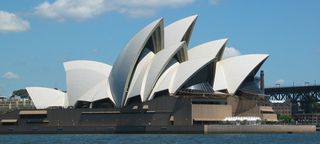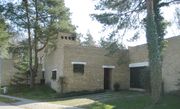Jørn Utzon

Jørn Oberg Utzon, AC (9 April 1918 – 29 November 2008)[1] was a Danish architect most notable for designing the Sydney Opera House in Australia. When the Sydney Opera House was declared a World Heritage Site on 28 June 2007, he became only the second person to have his work recognised as a World Heritage Site while he was still alive. [2]
Contents |
Early life and career
Utzon was born in Copenhagen, the son of a naval engineer, and grew up in Denmark. From 1937 he attended the Royal Danish Academy of Fine Arts where he studied under Kay Fisker and Steen Eiler Rasmussen. After graduating in 1942, he went to Sweden to work for Gunnar Asplund. After the end of World War II and the German Occupation of Denmark, he returned to Copenhagen. In 1946 he visited Alvar Aalto in Helsinki. From 1947–48 he travelled in Europe in 1949 in the United States and Mexico. In America he attended Frank Lloyd Wright's school in Arizona.[3] He started his own office in 1950 in Copenhagen. In 1950 he established his own studio in Copenhagen.[4]
Opera House design
In 1957 he unexpectedly won the competition to design the Sydney Opera House. Although he had won six other architectural competitions previously, the Opera House was his first non-domestic project. The designs he submitted were also little more than preliminary drawings. One of the judges, Eero Saarinen, described it as "genius" and declared he could not endorse any other choice.
Utzon refined his original conceptual designs for the shells over several years. One particular difficulty was that the Cahill government was so eager to commence the project that they arranged for the engineers, Ove Arup and Partners, to put out tenders for the podium without adequate working drawings; this work actually began in 1959 while Utzon was still in Denmark working on the final plans.
The extraordinary structure of the shells themselves represented a puzzle for the engineers. This was not resolved until 1961, when Utzon himself finally came up with the solution. He replaced the original elliptical shells with a design based on complex sections of a sphere. Utzon says his design was inspired by the simple act of peeling an orange: the 14 shells of the building, if combined, would form a perfect sphere.[5] Although Utzon had spectacular, innovative plans for the interior of these halls, he was unable to realize this part of his design. In mid-1965 the state Liberal government of Robert Askin was elected. Askin had been a 'vocal critic of the project prior to gaining office.'[6] His new Minister for Public Works, Davis Hughes, was even less sympathetic. Elizabeth Farrelly, Australian architecture critic has written that
| “ | at an election night dinner party in Mosman, Hughes's daughter Sue Burgoyne boasted that her father would soon sack Utzon. Hughes had no interest in art, architecture or aesthetics. A fraud, as well as a philistine, he had been exposed before Parliament and dumped as Country Party leader for 19 years of falsely claiming a university degree. The Opera House gave Hughes a second chance. For him, as for Utzon, it was all about control; about the triumph of homegrown mediocrity over foreign genius.[6] | ” |
Utzon soon found himself in conflict with the new Minister. Attempting to rein in the escalating cost of the project, Hughes began questioning Utzon's capability, his designs, schedules and cost estimates. Hughes eventually stopped payments to Utzon. Unable to pay his staff, Utzon was forced to resign as chief architect in February 1966.
When Utzon left, the shells were almost complete, and costs amounted to only $22.9 million. Following major changes to the original plans for the interiors that finally rose to $103 million.
In an article in Harvard Design Magazine in 2005,[7] Oxford University professor Bent Flyvbjerg argues that Utzon fell victim to a politically lowballed construction budget, which eventually resulted in a cost overrun of 1,400 percent. The overrun and the scandal it created kept Utzon from building more masterpieces. This, according to Flyvbjerg, is the real cost of the Sydney Opera House: "Utzon was thirty-eight when he won the competition for the Opera House - how would the work of the mature master have enriched our lives? We'll never know. That's the high price Sydney has imposed by its incompetence in building the Opera House."
The Opera House was finally completed, and opened in 1973 by Elizabeth II, Queen of Australia. The architect was not invited to the ceremony, nor was his name mentioned.[8]
Selected buildings



Major built projects:
- Water tower in Svaneke, Bornholm, Denmark, 1949–1951
- Architect's own house, Hellebæk, Denmark, 1950–1952 image
- Middelboe house, Holte, Denmark, 1953–1955 image
- Kingo Houses, Elsinore, Denmark 1956–1960
- Elineberg Housing, Helsingborg, Sweden, 1954–1966. Built by Swedish partners Erik and Henry Andersson image
- Planetstaden housing project in Lund, Sweden, 1956–1958. Built by Swedish partners Erik and Henry Andersson.
- Sydney Opera House, Sydney, Australia, 1956–1973
- Fredensborghusene, courtyard housing, Fredensborg, Denmark, 1959–1965 image
- Melli Bank University of Tehran Branch, Tehran, Iran, 1959–1960 archnet page
- Hammershøj care centre, Elsinore, Denmark, 1962–1966. Built by Birger Schmidt. image
- Bagsværd Church, Bagsværd, Denmark, 1968–1976 image
- Espansiva building system, pre-fabricated single family houses, Denmark, 1969
- Can Lis, Architect's own house, Majorca, Spain, 1971–1973 image
- National Assembly of Kuwait, Kuwait City, Kuwait, 1972–1984 archnet page
- Paustian Furniture Store, Copenhagen, Denmark, 1985–1987 image
- Can Feliz, Majorca, Spain, 1991–1994
- Skagen Odde Nature Center, Denmark, 1989 (completed by his son Jan Utzon in 1999-2000)[9]
Major unbuilt projects:
- High School in Elsinore, Denmark, 1958–1962
- Architect's own house, Bayview, Sydney, Australia, 1963–1965
- Museum dedicated to the work of artist Asger Jorn, Silkeborg, Denmark, 1963
- Theatre, Zurich, Switzerland, 1964–1970
- Jeita Theatre, Lebanon, 1968.
- Stadium, Jedda, Saudi Arabia, 1969
Awards and recognition
- RAIA Gold Medal from the Royal Australian Institute of Architects 1973
- 1978 RIBA Royal Gold Medal
- 1980 The Daylight and Building Component Award
- 1982 Alvar Aalto Medal
- 1992 Sir John Sulman Medal
- 1992 Wolf Prize
- 1998 Sonning Prize
- 2003 Pritzker Prize
Death and honours
On 17 May 1985, Utzon was made an honorary Companion of the Order of Australia (AC).[10] He was also involved in redesigning the Opera House, and in particular, the Reception Hall, following an agreement made in 2000. In March 2003, Utzon was awarded an honorary doctorate by the University of Sydney for his work on the Opera House. Utzon's son accepted the award on his behalf as Utzon himself was too ill to travel to Australia. He was also given the Keys to the City of Sydney. In 2003, he received the Pritzker Prize, architecture's highest honor.[11]
In March 2006, Queen Elizabeth II opened the western colonnade addition to the building that was constructed by Utzon in the last years without having been to Australia since 1966. His son, Jan, took his place in the opening ceremony instead, saying his father "is too old by now to take the long flight to Australia. But he lives and breathes the Opera House, and as its creator he just has to close his eyes to see it."
On 28 June 2007, the Sydney Opera House was declared a World Heritage Site.[12]
Utzon died in Copenhagen on 29 November 2008, aged 90, of a heart attack in his sleep after a series of operations. He died having never returned to Australia to see the completed opera house.[13][14] On 2 December 2008 the Parliament of New South Wales passed a special motion of condolence to honour Utzon's life and work[15]
On 25 March 2009, a state memorial and reconciliation concert for Utzon was held in the Concert Hall at Sydney Opera House.[16]
Literature
- Interview with Utzon, October 1992
- Arkitektur (magazine), Copenhagen 1947 #7–9, essay Tendenser i nutidens arkitektur by Jørn Utzon and Tobias Faber
- Arkitektur (magazine), Copenhagen 1970 #1, essay Additiv arkitektur by Jørn Utzon
- Zodiac 5 (magazine), Milan 1959
- Zodiac 10 (magazine), Milan 1962, essay Platforms and Plateaus: Ideas of a Danish Architect by Jørn Utzon
- Zodiac 14 (magazine), Milan 1965
- Sigfried Gideon: Space, Time and Architecture. Cambridge, Mass: Harvard University Press, 1967
- Kenneth Frampton: Studies in Tectonic Culture. Cambridge, Mass. & London: MIT Press, 1995. ISBN 0-262-56149-2
- Françoise Fromonot: Jørn Utzon, The Sydney Opera House. Corte Madera, California: Gingko Press, 1998. ISBN 3-927258-72-5
- Richard Weston: Utzon — Inspiration, Vision, Architecture. Denmark: Edition Bløndal, 2002. ISBN 87-88978-98-2
- J.J. Ferrer Forés: Jørn Utzon. Obras y Proyectos. Works and Projects. Spain: GG 2006. ISBN 978-84-252-2060-9
- Katarina Stübe and Jan Utzon, Sydney Opera House: A Tribute to Jørn Utzon. Reveal Books, 2009. ISBN 9780980612301
See also
References
- ↑ "Sydney Opera House designer Joern Utzon dies". Associated Press. 2008-11-30. http://www.google.com/hostednews/ap/article/ALeqM5ikmCHVv0stlSnIJYFrpEDVBq8I3wD94OKMGO0. Retrieved 2008-11-30.
- ↑ Kathy Marks (27 June 2007). "World Heritage honour for 'daring' Sydney Opera House". The Independent. Independent News & Media. http://www.independent.co.uk/news/world/australasia/world-heritage-honour-for-daring-sydney-opera-house-455193.html. Retrieved 14 September 2009.
- ↑ Jorn Utzon from Telegraph, 30 November 2008.
- ↑ "Jørn Utzon". Famous Architects. http://famedarchitect.com/jorn-utzon/. Retrieved 2010-06-20.
- ↑ Sydney Opera House: Celebrating the arts and architecture from CNN. Retrieved 18 December 2008.
- ↑ 6.0 6.1 Farrelly, Elizabeth, 'High noon at Bennelong Point' in Canberra Times, http://www.canberratimes.com.au/news/national/national/general/high-noon-at-bennelong-point/1374056.aspx?storypage=0, Accessed 1 December, 2008
- ↑ http://flyvbjerg.plan.aau.dk/HARVARDDESIGN63PRINT.pdf
- ↑ The Age: Obituary
- ↑ http://www.arcspace.com/architects/utzon/skagen.html Skagen Odde Nature Center on ArcSpace.com
- ↑ It's an Honour: AC
- ↑ Sydney Morning Herald - his death
- ↑ Unesco website: Sydney Opera House
- ↑ OLSEN, Jan (2008-11-29). "Sydney Opera House designer Joern Utzon dies at 90". Associated Press. http://www.google.com/hostednews/ap/article/ALeqM5ikmCHVv0stlSnIJYFrpEDVBq8I3wD94OM2F00. Retrieved 2008-11-29.
- ↑ BERNSTEIN, FRED (2008-11-29). "Jorn Utzon, 90, Dies; Created Sydney Opera House". The New York Times. http://www.nytimes.com/2008/11/30/arts/design/30utzon.htm. Retrieved 2008-12-04.
- ↑ "Ministerial Statement, Death of Joern Utzon". Hansard. 2008-12-02. http://www.parliament.nsw.gov.au/prod/PARLMENT/hansArt.nsf/V3Key/LA20081202021. Retrieved 2009-04-28.
- ↑ "Sydney Opera House architect Joern Utzon remembered". The Daily Telegraph. 2009-03-25. http://www.news.com.au/dailytelegraph/story/0,22049,25239988-5013438,00.html. Retrieved 2009-04-28.
External links
- Utzon Center
- Pritzker Architecture Prize 2003, including essays and photographs.
- The Kingohouses website
- The Sydney Opera House history
- The Edge of the Possible, 58 minute documentary, 1998, Dir: Daryl Dellora, Film Art Doco Pty Ltd
- Design by Deception: The Politics of Megaproject Approval
- Obituary in The Economist, 11-Dec-2008.
|
|||||||||||||||||
|
|||||